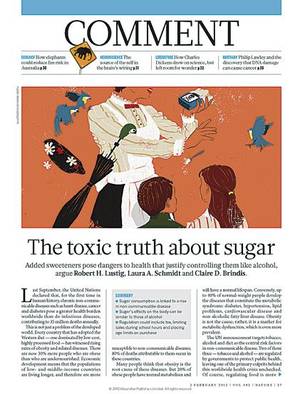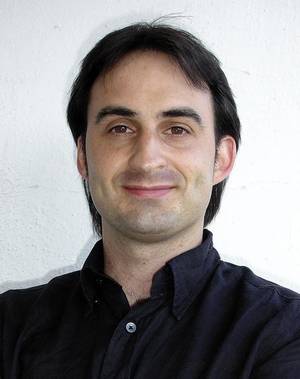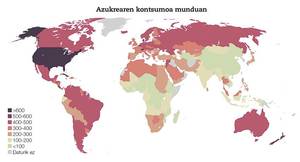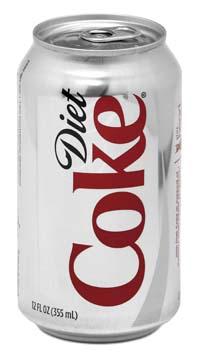Sugar, sweet toxic
2013/11/01 Galarraga Aiestaran, Ana - Elhuyar Zientzia Iturria: Elhuyar aldizkaria

Among the authors of the article The toxic truth about sugar (The toxic truth of sugar) are: Robert Lustig, Laura Schmidt and Claire Brindis. The three researchers at the University of California have published their opinion in the journal Nature in February 2012. According to the article, sugar and alcohol have a similar effect on health and propose measures to reduce the consumption of sugar such as the imposition of taxes on sugary products and limit the sales hours and the minimum age of buyers.
The debate that prompted the article has not yet been put out. There are those who think that putting the sugar to the height of the poison is excessive and remember that it is only a disaccharide of glucose and fructose, essential food of the cells. For many, the problem is not sugar, but obesity.
However, the three researchers have explained in the article that 20% of obese people have normal metabolism and that their life expectancy is not less than that of the rest. On the contrary, 40% of people with adequate weight develop diseases that are included in metabolic syndrome: cardiovascular diseases, hypertension, diabetes, lipid disorders and non-alcoholic fatty liver disease. From this it follows that obesity is not the cause of diseases, but of metabolic alterations.
They also warn that, according to the United Nations, three are the main risk factors for non-communicable diseases: tobacco, alcohol and diet. In spite of the strict regulations regulating the consumption of tobacco and alcohol, the same does not happen with the diet. The authors are aware that the regulation of food is not so simple, in short, they say that "food is necessary, while tobacco and alcohol are not essential". For this reason, they consider that it is necessary to define what part of the diet should be controlled. They have it clear: the added sugar should be delimited to drinks and foods.
Do not match those who define sugar as "pure calories": "There is nothing empty in these calories," the article states, "There is more and more evidence that fructose favours processes that cause liver toxicity and many other chronic diseases." Without a doubt: "A little is not a problem, but many kill (slowly)."

Equivalent to alcohol
In this sense, the influence of fructose on health has been comparable to that of alcohol. According to them, similarity is not surprising, since alcohol comes from the fermentation of sugar. They underline that chronic consumption of both can lead to hypertension, heart disease, dyslipidemia, pancreatitis, obesity, malnutrition and liver alteration. In addition, productivity losses and health expenses associated with these diseases have been calculated.
In terms of addictive capacity, alcohol and sugar are similar: "Sugar has a clear risk of falling apart. Like tobacco and alcohol, it encourages you to take the next time." Sugar disrupts the work of hormones that act in the feeling of saturation. Among other things, it reduces the decrease of the grelina after eating and also influences the functioning of leptin. In turn, it reduces the signal of dopamine in the brain rewards system and, therefore, reduces the pleasure that generates food and encourages you to continue eating.
Sweet: basic and award
Apart from the effects on the health of sugar, what do sugary foods and beverages have to make them so attractive to consumers? Bittor Rodríguez of the UPV-EHU considers that two are the main agents, one physiological and one by education.

"From a physiological point of view, sugar is a basic energy source, so we turn to sweet foods and drinks," Rodríguez explains. However, it seems to him a stronger agent than that: "In fact, the only food we consume in the first six months of our life is breast milk. And breast milk is sweet. So in the first six months we did not take any other flavor. Then, little by little, they are introduced into the diet foods with other flavors, which are often difficult to assume. However, at the end of the meal it is normal for the child to give some sweet taste: bottle, some milk..."
According to Rodríguez, this custom is maintained until adulthood. "In adulthood it is also common for the dessert to be sweet. So we've got used to it, and that's what we like, because the memory of the sweet taste is fixed in the brain since childhood. There will always be a prize."
Measures to limit consumption
Bittor Rodríguez considers it necessary to control consumption. "This control can be done by oneself. But also the administration. In short, the consumption of many other things is also regulated," he said.

Like Rodríguez, the authors of the article "Toxic Truth of Sugar" appeal to the administration to adopt measures that limit the consumption of sugary foods and beverages. "The imposition of taxes on alcohol and tobacco is the most widespread and effective way to reduce tobacco and smoking consumption, along with dependence and collateral damage," they say. In addition, they consider that individual education campaigns, such as school education programs, are not successful.
However, the tax proposal for sugary products is not completely new. This option has been analyzed in different places in Europe, as in 2012 in France and Italy and last year in Catalonia. In some North American cities, on the other hand, the size of sugary soda glasses has been limited by law in order to reduce consumption, including in New York. In all cases, the companies that produce these beverages have shown themselves contrary to the adoption of measures and finally the proposals have not advanced.
However, the authors of the article, Rodríguez and many other experts believe it is time to address the issue harshly. "Experience shows that price and fiscal policy influence consumption. And the lack of hands also influences," says Rodríguez. "An example of this is alcohol and tobacco, which can also be made equal with sugar." Lustig, Schmidt and Brindis are also of the same opinion, and although they recognize that it will be difficult, they believe it can be achieved -- they literally consider it "a possible dream" (possible dream).
Rodríguez warns that until now, consumer reorientation policies have been used in another direction: "For example, in our environment we eat too much meat, to the point of harming health. And in this they have and have had great influence the policies of promotion and reduction of meat production. The same applies to maize or soybeans: production is subsidized and advertising campaigns are carried out to promote their consumption and products derived".
For all this, he is advocating for establishing policies that limit sugar consumption "since today too much is driven and too much is consumed." Thus, in addition to establishing an adequate fiscal policy, Rodríguez considers it necessary to control advertising. And it is that he believes that advertising has a great influence: "This is clearly seen in non-industrialized countries: people have no money to buy basic things, but to drink soft drinks."

Impact on benefit
According to Rodríguez, marketing companies are based on behavioral theories to influence consumers. These same theories, however, can serve to adopt healthy trends, as demonstrated by Rodríguez and his team with the project they have carried out in collaboration with the City Council of Vitoria-Gasteiz.
In fact, a 2007 study in Vitoria-Gasteiz reveals that 90% of children did not eat enough vegetables and that only 20% ate enough fruit. To change this trend, the UPV/EHU School of Pharmacy together with the Vitoria-Gasteiz City Council designed a complete project. Directed by Rodríguez himself, the team is made up of experts from different disciplines: dietists-nutritionists, a sociologist and an expert in sensory analysis.
The project includes activities and family games, in school and on the street, such as going to buy fruit, preparing a salad, having breakfast with family or testing the senses (with apples of banana smell, for example). For the moment it is succeeding, since 80% of children have acquired the nutritional, sensory and gastronomic contents worked in the project, and 90% have announced that they will eat more fruit than before. "Through the project we have influenced - Rodriguez- in the behavior of children, but in this case with a good objective".

Gai honi buruzko eduki gehiago
Elhuyarrek garatutako teknologia




